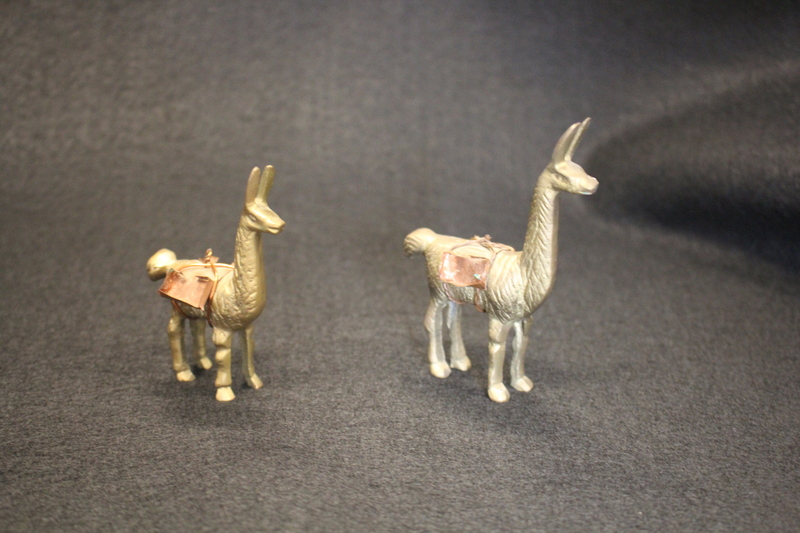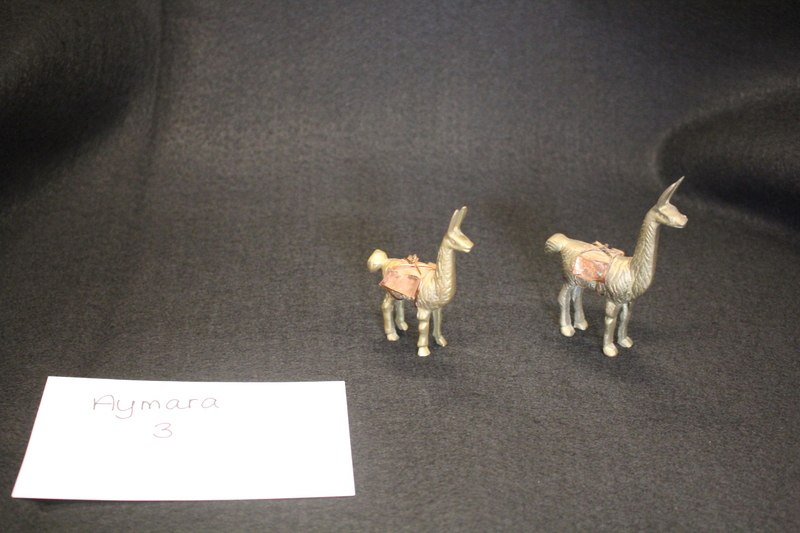Peruvian Copper Llama Figurines
Title
Subject
Domestication
Peruvian Americans
Sculpture, Peruvian
Description
Made of copper, these two Peruvian llama figurines stand approximately one inch tall and one inch long. With textured bodies and carved hooves and faces, these figurines are individually unique. Both figurines have double sided satchel baskets strapped to their backs that hang down on their sides. The baskets originally had items inside of them but over time and with travel, they have since broken off. These Peruvian llama figurines were given to Aymara Yllanes by her mother, who received them from her uncle – it is unknown who he may have received them from but they have been in the Yllanes family for a long time. Aymara’s mother is Peruvian and her father is Puerto Rican, and she is often reminded about her Latino origins through her family’s heirlooms. Aymara keeps these llama figurines on her bedroom dresser and looks at them every morning to remind herself where she is from and where she has been. It is not uncommon for family members to pass down heirlooms to children to help them connect with their heritage and culture.
Llamas are a domesticated South American mammal, primarily used by Peruvian cultures for transportation through the vast mountains in the southern highlands of Peru. Hardy animals, llamas are used to carry water, building materials, and traded goods. They also provide dung for fertilizer, wool for textiles, and meat for food. Agriculture and llama domestication supported the Incan empire and other South American and Latino cultures for centuries. A reliable and sturdy animal, the domestication of the llama has triggered a societal change that has produced the settlement of cities and the development of Latino culture.
Besides their durability and wool and meat production, Llamas were also used during Incan religious ceremonies. The prime sacrificial animal of the Incan empire, llamas were sacrificed to the gods and are still sacrificed today. Peruvians hold important festivals in the mountain highlands where they sacrifice llamas for fertility and strong herds. Stone llamas are then placed in pastures in an effort to ensure the fertility of the herd. After a llama is sacrificed, its blood is drained and put all throughout the town. Llama figurines more similar to the ones pictured above were often buried with the Incan dead, perhaps as offerings to the gods to ensure fertility of the Inca herds.
While these Peruvian copper llama figurines are not a representation of Puerto Rican culture, they do however, connect to Latino culture as a whole. Agriculture and domestication are a large part of Latino lives, no matter where in the world. Many Puerto Ricans migrated from the island to the United States in order to work on farms with crops and animals. Aymara’s grandfather moved from Peru to the United States for work in the same manner as Puerto Ricans did, searching for agricultural employment. These small Peruvian copper llama figurines are a small homage to domestication, agriculture, Peru, and Latino heritage.
Anning, Caroline. “Inca Success in Peruvian Andes ‘thanks to llama dung.” BBC News. Accessed May 5, 2018. http://www.bbc.com/news/world-latin-america-13439093.
Benson, Elizabeth and Anita G. Cook. Ritual Sacrifice in Ancient Peru. Austin: University of Texas Press, 2001.
Glasser, Ruth. “Tobacco Valley: Puerto Rican Farm Workers in Connecticut.” Connecticut Explored, 2002.
“Inca Mummies: Secrets of a Lost World, Little Llamas.” Nationalgeographic.com. Accessed May 5, 2018. https://web.archive.org/web/20060907054938/http://www.nationalgeographic.com:80/inca/inca_culture_4.html.
Shimada, Melody and Izumi Shimada. “Prehistoric Llama Breeding and Herding on the North Coast of Peru.” American Antiquity. (1985) 50 (1): 3 – 26.
Creator
Source
Publisher
CCSU Public History

